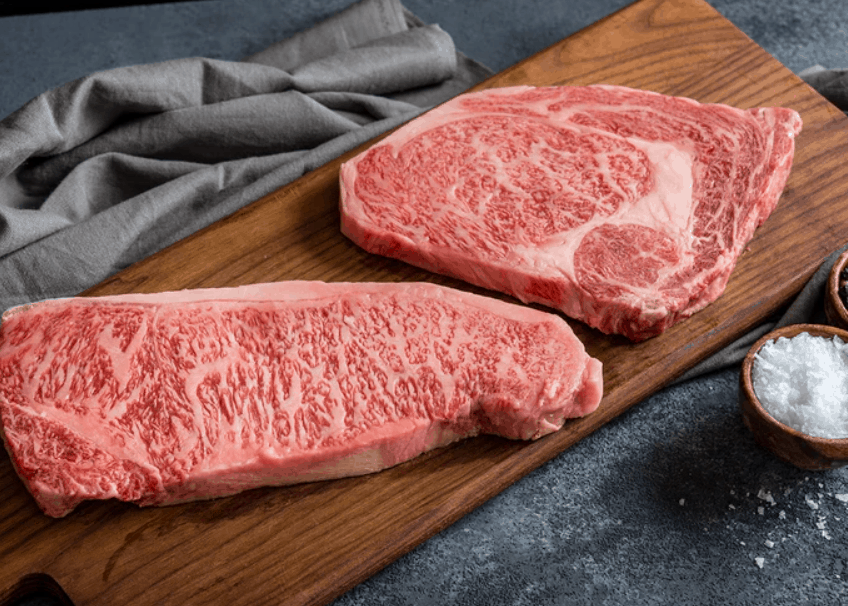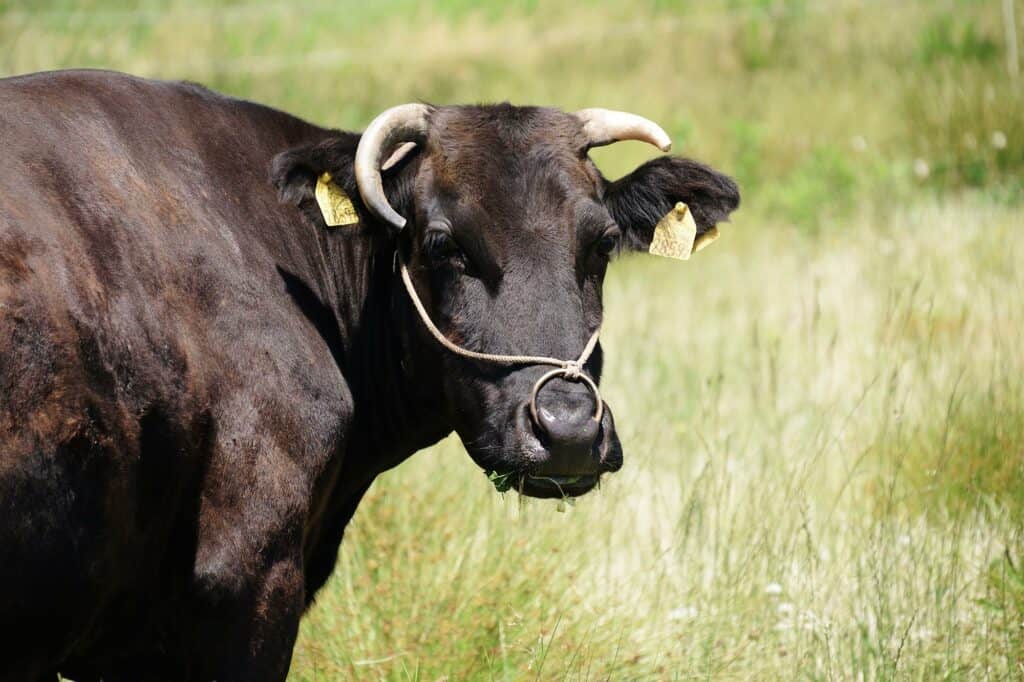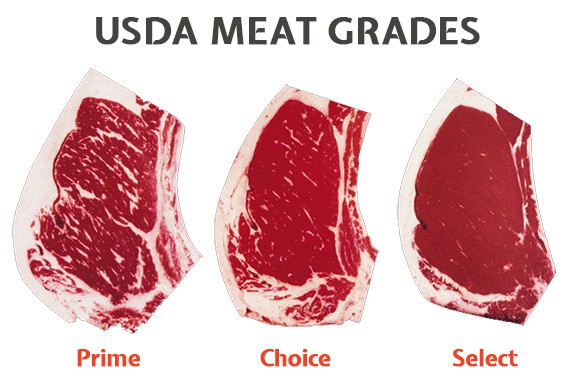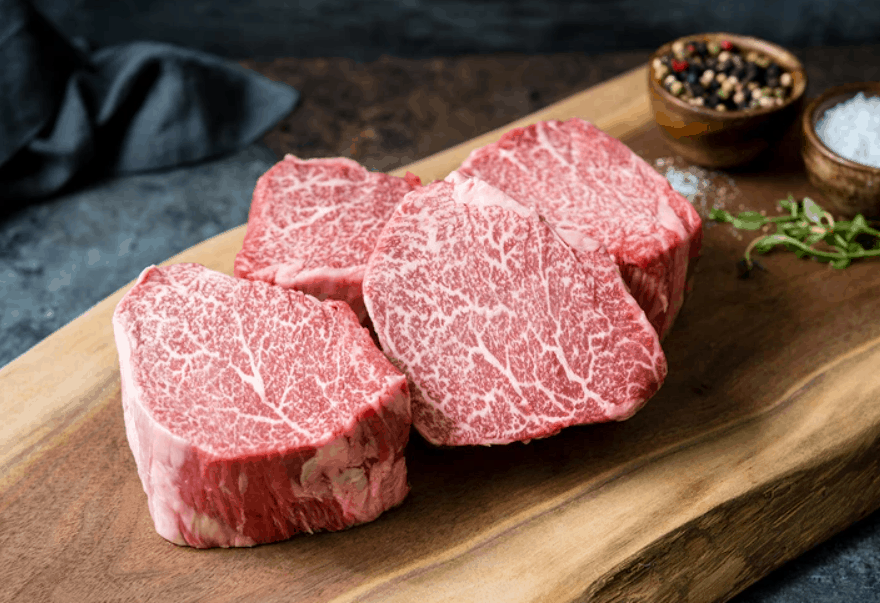- Good Chop Review: Is It Really Worth It? - November 20, 2021
- Rastelli’s Meat Review: Is It Right For You? - October 5, 2021
- Farm Foods Market Review: Is It Worth Your Money? - August 20, 2021
If you’re a steak enthusiast, then you probably have that one type or cut of steak that you’ve never had. You’ve always wanted to try it, but you haven’t been able to make it happen. For me, it’s a nice, delicious cut of Japanese Wagyu beef. As you may have guessed, this type of steak originated in Japan.
Japanese ranchers are dedicated to performing rigorous tasks to ensure their beef is the best in the world. This top-quality steak regularly fetches more than $100 per cut. So don’t be surprised if you go looking for some and it requires you to open your wallet just a little further than normal.
Is Wagyu as good as advertised? I can’t answer that question, but one thing is for certain: it’s a beef like none other on the market. Experts say it has amazing flavor, and the meat itself can be traced back to amazing Japanese traditions that have been kept for centuries. This is just one of the reasons people from around the globe want to get their hands on Wagyu beef.
What is Japanese Wagyu Beef?

Wagyu literally translates to ‘Japanese cow,’ which is precisely where the beef originates. However, there is much more to this delicious steak than the cattle that it comes from. Wagyu beef is surrounded by Japanese pride, tradition, and farming culture.
Many people don’t know that Wagyu beef comes from several different types of cattle, which we’ll talk about more in a moment. These cattle are all raised and cared for in specific ways that offer the best cuts of steak a person could ask for.
A key principle Japanese ranchers focus on is creating a stress-free environment for their Wagyu cattle. This leads to the best possible red meat. Additionally, they take extra care when feeding the cattle. As a result, Wagyu cows are fed a diet that perfectly optimizes their metabolism while keeping them in great health.
This type of care aids in both meat development and the growth of the animal. As a result, you’ll get a fantastic steak, no matter where it’s from. For years, Wagyu beef has been the king of the world of steak, and it doesn’t appear as though that’s going to change in the near future.
Types of Cattle
If you’re looking for authentic Wagu beef, it’s going to come from one of four types of cattle raised in Japan:
- Japanese Black (Kuroge)
- Japanese Brown (Akage)
- Japanese Polled (Nihon Mukaku)
- Japanese Shorthorn (Nihon Tankaku)
Of course, there are other cattle raised in Japan, but these types of beef are not used for Wagyu. Instead, the type of cow you’re most likely to consume is the Japanese Black. This is because these animals offer amazing marbling. Japanese Black cattle grow their fat within the muscle as opposed to outside of it.
This leads to amazing and perfect marbling throughout the cut, which is something you don’t often find in other cattle types. Japanese ranchers have bred their Wagyu in a specific manner for generations to make them the high-quality beef they are today. As a result, you get cattle that produce excellent marbling that you’re not going to find anywhere else in the world.
Raising Japanese Wagyu Cattle

Wagyu cattle raised in Japan live a life of luxury. These cattle are raised in serene, peaceful environments because the Japanese believe this leads to better meat quality. As a result, every animal meant for Wagyu experiences a stress-free, peaceful life. They are fed nutrient-rich food, fresh water and allowed to graze at their leisure on natural grass.
Japanese farmers do everything they can to provide a stress-free life for their cattle. This includes keeping families together and massaging cows to loosen up their muscles after being out in the pasture all day. In addition, ranchers diligently check on their herd throughout the day to watch for signs of stress, ensure that fresh food and water are always available, and show the cows appreciation and affection.
This process is what makes Wagyu cattle from Japan what it is today. People around the world know about Japanese Wagyu because of the considerable measures taken by ranchers to provide their cattle a stress-free life.
Grading Wagyu Beef
There are different grades used for Wagyu beef in Japan. However, it’s similar to the USDA grading system used in the United States for beef. The grading system uses both numbers and letters to show the quality of the beef. Letters indicate the yield, which is the amount of quality beef that came from one Wagyu cow. The number shows the quality of the beef.
The best grade available is A5. A cow that gets this grade has produced both a high yield of excellent quality meat and high-quality beef. Don’t be surprised if a cut of A5 Wagyu beef is expensive. However, it will have the perfect blend of marbling, color, and texture.
Marbling Scores

Wagyu has its grading scores and a separate marbling score, which measures the intramuscular fat of the beef. This is known as marbling. Marbling is the creamy white webbing that cuts through the beef. This is what gives Wagyu its juiciness, tenderness, and rich flavor. This score is known as the BMS or Beef Marble Score.
Japenese Marbling Scale
The BMS scale ranges between 3 and 12 in the Japanese system. 3 is the absolute minimum a steak can have, while 12 is a steak that is nearly white with marbling. Since a score of 1 or 2 has no marbling, they are not considered in the ranking system. More marbling means a steak will have a creamy, tender texture, which is what makes Wagyu beef so sought after. As a result, the higher the BMS score a cut of Wagyu beef gets, the more expensive it’s going to be.
Australian Marbling Scale
Outside of Japan, one of the biggest producers of Wagyu is Australia. However, Australia uses its own separate grading scale for its beef, the AUS-MEAT marbling system. The scale starts at 0, which is no marbling, and goes to 9+, which is an amazing amount of marbling.
Grading scores for Australia and Japanese are the same, meaning a Wagyu cut that gets a BMS 5 in Australia is the same as a cut that gets a BMS 5 in Japan. However, the Australian scale has a high score of 9, whereas Japan goes to 11. So anything above 9 in Australia is given a grade of 9+.
US Marbling and Grading
In the United States, the USDA separates its meat into three distinct categories: Select, Choice, and Prime, which is the best you can get. For a frame of reference, a Prime steak in the US would be the same as a BMS 3-4 in Japan.
Something to keep in mind is that there are Wagyu offerings in the United States, which are often a cross of American Angus and Japanese Wagyu breeds. If it’s a US breed, it will follow the USDA rating system. If, however, it’s a true Japanese Wagyu cut of beef, it will use the Japanese BMS rating.
Wagyu Filet Mignon

The filet comes from the tenderloin of the cow. This is a muscle that doesn’t move a lot, so it’s very lean and tender. When you get a high-quality cut of Wagyu filet mignon, you’ll notice that it has high levels of marbling. That means it’s very tender, which makes it very smooth and velvety to the touch.
Its sweet and mild flavor, along with its supple texture, are just a few reasons people love filet mignon. Unfortunately, this small cut of meat has a large amount of taste, which makes it one of the more expensive cuts on the market. It’s not always true that you get what you pay for, but in this instance, it is.
When it comes to cooking your filet mignon, keep in mind that it’s a very tender cut of beef. Most people prefer to cook theirs on a grill. No matter which type of cooking method you prefer, be sure you only use dry heat for your Wagyu filet mignon. One last thing to keep in mind is that you don’t want to cook your filet more than medium-rare. Anything more, and you’ll lose the tender, delicious, juicy flavor Wagyu steaks are known for.
Wagyu vs Kobe
There are many different types of Wagyu, which we touched on previously. Every type comes from a different region in Japan, so each type has its own unique and distinct flavor. One such type is Kobe beef, which is an offshoot of Wagyu. It’s just as tasty and even more sought after than Wagyu.
Wagyu comes from different ranchers throughout Japan, but Kobe beef is more restrictive. If you’re looking for authentic Kobe, it will come from Tajima cattle. These cows are raised only in the Hyogo prefecture of Japan. Cattle that are raised, fed, and processed in this prefecture are the only source of genuine Kobe in the world. Typically there are no more than 4,000 head of cattle raised for Kobe beef every year.
FAQs
Here are a few commonly asked questions about Wagyu beef.
Question: How Does Wagyu Beef Taste?
Answer: When you finally take a bite of a delicious cut of Wagyu filet mignon, you’ll know why it’s so coveted by steak aficionados around the world. Of course, Wagyu steak tastes like steak, but this delicious and unique beef has its own distinct flavor. Authentic Wagyu has an amazing buttery flavor that is almost as incredible as the beef itself.
Wagyu is very rich, which means the filet mignon cut is the perfect amount to satisfy even the most ardent steak lover. Additionally, Wagyu beef is well-known for its texture. It is so tender it almost melts in your mouth. Some go so far as to suggest you don’t even have to chew it before swallowing.
Question: Why is Wagyu So Expensive?
Answer: One pound of Wagyu meat will probably run between $100 and $200. That’s quite a price tag for a hunk of meat. However, ask anyone who has had just a taste of Wagyu beef, and they’ll tell you that the price tag is well worth it. It’s so expensive because of the methods and care that goes into raising each cow.
The standards and breeding requirements necessary for Wagyu cattle are higher than any other cattle you’re going to find. In addition, ranchers raise their cattle in a stress-free environment and provide them fresh water and food that aids in growth and development. All of this and much much more goes into producing what many steak connoisseurs believe to be the best steak in the world.
Question: Is authentic Wagyu healthy?
Answer: No matter how you cook it, steak isn’t known for being a particularly healthy food. However, if you stick to the recommended three ounces of red meat, steak has low calories, no carbs, and offers plenty of protein. Additionally, there’s plenty of B-12, Iron, and a variety of other nutrients in every serving of steak you eat.
The great thing about Wagyu beef is that it has high levels of monounsaturated fat, which is a good kind. It’s actually more prominent in Wagyu beef than it is in other types of steak. So, so long as you keep your portions reasonable, there are plenty of health benefits with eating Wagyu beef.
Wagyu Filet Mignon Cut: One of the Best Cuts of Beef in the World
Japanese Wagyu filet mignon is, without a doubt, one of the most sought-after cuts of steak in the world. It offers amazing marbling and tender texture, all of which is due to the devotion of Japanese ranchers. These cattle are raised in stress-free environments and given only the best quality and care possible.
Wagyu filet mignon is a must-have if you love steak. Yes, it’s a little on the expensive side, but if possible, set aside a little money and splurge on this amazing cut of beef. Make it part of your birthday or anniversary. You’ll be glad you did when the bold, unparalleled flavor and texture of a Wagyu filet mignon hits your tongue.

